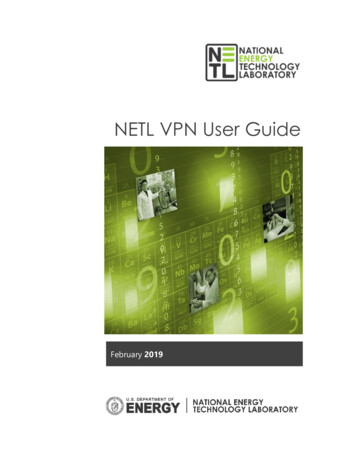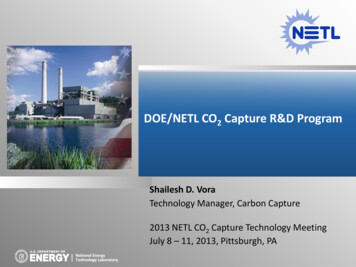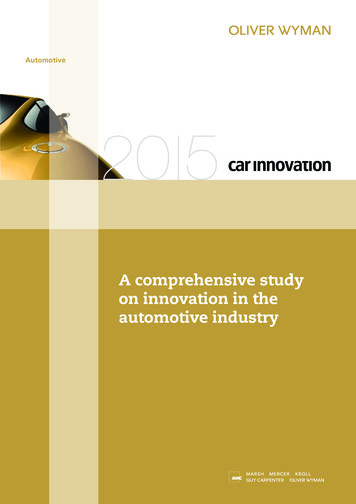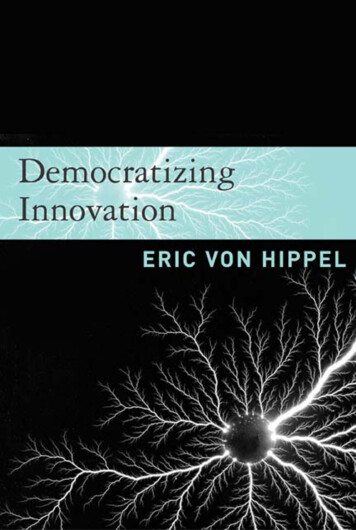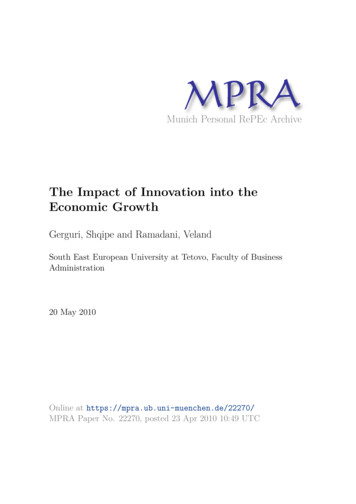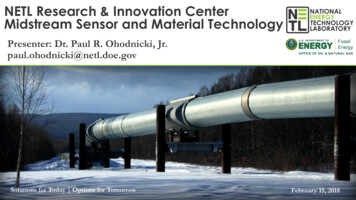
Transcription
NETL Research & Innovation CenterMidstream Sensor and Material TechnologyPresenter: Dr. Paul R. Ohodnicki, Jr.paul.ohodnicki@netl.doe.govSolutions for Today Options for TomorrowFebruary 15, 2018
Embedded Sensing in Fossil Energy ApplicationsNeeds for increased visibility span all aspects of the US Energy InfrastructurePowerGenerationUnconventionalOil & GasNatural Gas InfrastructureCO2SequestrationUbiquitous Embedded Sensors Combined with Geo-spatial Data Analytics is a Requirement toAchieve Desired Visibility Across the Entire Fossil Energy Infrastructure : NETL Initiative2
Engagements with Extramural ProgramsAdvancedNETL Research &FunctionalInnovation CenterSensor MaterialFacilities and StaffProject TeamExtramuralCrosscuttingExtramural ProgramsProgramResearchThe Team Seeks Synergistic Interactions with a Broad Range of Extramurally SupportedNETL Funded Projects to Help Drive the FE Mission in Support of Our Program Offices.3
Natural Gas Infrastructure Reliability & ResiliencyPipeline a Analytics& rastructure%20V 02-02.pdfA Program was Established to Develop New Sensor and Material Technologies for Monitoring,Detection, and Mitigation of Failures and Events in Natural Gas Infrastructure.4
Conventional Monitoring TechnologiesPipeline Explosion Caused by CorrosionPrimary Emphasis : Detecting Presence of Leaks and Failures Internal Leak Detection Systems: Measured Flow Ratesand Computational Models Periodic In-Line Inspections Monitoring of Local Geohazards(Ground Movements and Seismic Events) External Inspections, Including Aerial Surveys Optical Fiber Based Leak Detection Systems:Indirect Measurement (Temperature, Strain, #stream/0Conventional Monitoring Techniques Identify Leaks and Events Once they Have Occurred toEnable Faster Responses, But are Limited in Capability to Identify Failures Before they Occur.5
Data Analytics, Sensors & Materials TechnologyGoal Optimized Sensor and Protection Systems to Prevent Failures and LeaksRegionalTrends in DataGas Transmission Leak SourcesGas Transmission Leak SourcesDetectable leaksPipeline related causes – 99% ConfidencePipeline related causes – 95% ConfidencePipeline related causes – 90% ConfidenceNo dominant causesExternal related causes – 90% ConfidenceExternal related causes – 95% ConfidenceExternal related causes – 99% ConfidenceOptimize Sensor &MaterialDevelopment &DeploymentIdentifyTechnologyNeedsNon-Detectable leaksAnalytics Methodologies can Be Developed and Applied in Parallel with New Sensor andMaterials Research and Development Efforts to Impact Infrastructure Risks and Resiliency.6
Intelligent and Flexible Pipeline InfrastructureDistributed SensorInterrogator (DSI)Emphasis Within NETL Research & Innovation Center: Optimized Sensor Network & Interrogation (Range, Resolution, Cost) Internal Corrosion On-Set Detection and Prevention Methane Leak Detection & In-Pipe Gas Composition MonitoringMonitoring and Manage Pipeline Structure Health Monitoring Infrastructure Perimeter Security Hotspot detection Early Corrosion Prediction & Quantification Methane Leakage AlertKey Questions for Industry: What are the Cost Constraints and Value of the Information Content?7
Suite of Complementary Sensing TechnologiesDistributedOpticalSensorOptic ChemicalFiberFiber SensorsEvanescentImperfections in fiber lead to Rayleigh nb)c)DistributedOptical FiberSensorsResonantAntenna f2c) d)CostLinear SensorAdjustablef1 andDistanceResolutionOptical FiberNovel Wireless TelemetryAdditively EmbeddedPlaceholder forFunctionalized Surface Acoustic Wave SensorLeveraging High TemperatureSensorWireless SensorsFiber OpticPassiveCoaxial CableDesignsCoaxialSensorCables and AntennaFunctionalized sorsCommunication in DirectionWellbore ConceptAdvancedGraphicf2 SensorElectrochemicalPointf1SensorsResonantAntenna f1entTransmissionAttenuationRayleigh backscatter forms a permanent spatial“fingerprint” along the length of the fiber.ensorrAttributesResonantAntenna f1IndicatorMoleculeNovel Wireless TelemetryEmbeddedAdditivelyAdvancedFiber Optic SensorSensors Leveraging High TemperatureElectrochemicalDesignsCoaxial Cables and AntennaGeospatialCost Per Sensor“Node” LowLowModerate toHighTargetedFunctionTRLTemperature, Strain,Gas Chemistry (CH4,CO2, H2O, etc.)2-3Early CorrosionDetectionTemperature, Strain,Gas Chemistry (CH4,CO2, H2O, etc.)Early CorrosionDetectionHumidity andCorrosion RateMonitoring2-33-4onanttenna f2Silicon Integrated Circuit SensorPlaceholder forCoaxial CableSensorSAWzed icPatchThree Synergistic Sensor Platformswith ComplementaryCost, Performance, and GeospatialWirelessBasedPatchTechnologyWave Sensor TechnologyCommunicationCharacteristics are Being DevelopedwithinanDirectionEmphasisAntennason Corrosion & Gas Composition.Wellbore ConceptOptical fiber based sensor elementsSimple, passive devices withGraphicWirelessand telemetrywireless telemetryf28High TemperatureSensorsFunctionalization with sensing
Suite of Complementary Sensing 20192nd GenerationWireless, Low Cost1st GenerationPrototype Wired1st FieldValidationsDistributed OpticalFiber Sensors,Passive WirelessSensorsFY2025FY2020Early Stage Technology Development2nd ype Deployment &Telemetry Optimization1st g Platforms Under Development Have Complementary Technology Readiness Levels.Notional Timelines Illustrate the Progression Towards Commercialization with Industry Partnerships.9
Early Successes and Accomplishments(a)(b)1.611.40.70.51.840Phase (degree)0.30.20.10.050.012.00.8Phase (radian)2.210003020100CO2 (SAW, 2-cycle)80012000Time (min)406080 1(d)Phase (degree)0.10.050.01Technology#2: Successful Demonstrations2.12.16(SAW, 2-cycle)of Wireless Chemical ed, Under Review, J Devkota, 1.5KJ Kim, PR Ohodnicki,2.121.2 arXiv:1712.08468JT Culp, DW Greve, JW Lekse, arXiv preprint1Provisional Patent Application Filed, Publications In Press for Corrosion 201820CO2 concentration (vol-%)(c)Phase (radian)Technology #1: Optical Fiber Based WaterCondensation Detection and Characterization(SAW, 2-cycle)2.08CH4 (SAW, 2-cycle)02004006000.90.60.310
Suite of Complementary Material TechnologiesMetallic CoatingsPolymer / Metal /Polymer LinersMetallic CoatingsPolymer / Metal /Polymer rmal spray 5-250/ft2Sacrificial Coating ControlsCorrosion of Pipeline.3-4Hybrid Liner Slows theTransport of Water andCorrosive Gas Species tothe Pipe Interior Surface2-3Hybrid Polymer CoatingSlows the Transport ofWater and Corrosive GasSpecies to the Pipe Inferior.2-3Pull-throughand inflate 10K/mileEngineered Polymer CoatingsEngineeredPolymer LinersSprayingand/or fluidiccoatingTBDA Suite of Synergistic Coatings and Liner Technologies are Being Developed to ImproveCorrosion Resistance for More Resilient and Flexible Natural Gas Pipelines.11
Suite of Complementary Material TechnologiesFY2018MetallicCoatingsFY2019Corrosion Testing andBenchmarkingProcess Scaling with Industry1st FieldValidationsHybrid Polymer / Metal /Polymer Liners, AdvancedPolymer CoatingsFY2025FY2020Early Stage TechnologyDevelopment2nd ion Testing & Benchmarking1st al Technologies Under Development also Have Complementary Technology Readiness.12
Early Successes and AccomplishmentsCorrosion ofSac. Couple,mm/yTemp, Coupled to Al40CO230.010.78X65-Coupled to Zn40CO230.010.10MaterialTechnology #1: Zn and Zn-alloy Based CoatingLayers are Showing Significant ImprovementsRelative to Base Alloys in Terms of Corrosion.Technology #2: Improved Polymer / Metal/ Polymer Liners as Compared toCommercially Available Liners.13
Sensor / Material Integration : “Intelligent Pipelines”Optical Fiber Integrated Alloys :Structural and Corrosion MonitoringSensor Integrated Coatings and Liners :Intelligent Protection SystemsEfforts to Integrate these New Technologies are Beginning toInitiate in the Upcoming Project Year : April 1st.The Ultimate Goal of the Program is to Bring the Technologies Together to Realize theVision of “Intelligent Pipelines” through Sensor-Infused Pipeline Materials.14
Summary and Key Take-Aways NETL R&IC Has an Established Program in New Technology Development for Midstream Goal Enabling a Vision of an “Intelligent Pipeline” Enabled by Advanced Technologies Geospatial Data Analytics Advanced Embedded Sensors New Protective Coatings and LinersC H 4 C O 2 H 2S We are Actively Seeking Industry Partnerships and CollaborationsDr. Paul R. Ohodnicki, Jr.WaterCorrosionTemperatureStrainAcoustic field& V i b ra t i o nPaul.ohodnicki@netl.doe.gov412-386-738915
- Detection and Localization of Leaks That Occur Distributed Optical Fiber Sensors (Additively Embedded in Casing) I n d ic a to r Mo le c u le C o re O p tic a l F ib e r C la d d in g E v a n e s c e n t F ie ld E x c i ta ti o n T ra n s m is s io n A tte n u a tio n a) b) d) e) c) Fiber Optic Chemical Sensor Additively Embedded Fiber Optic .
